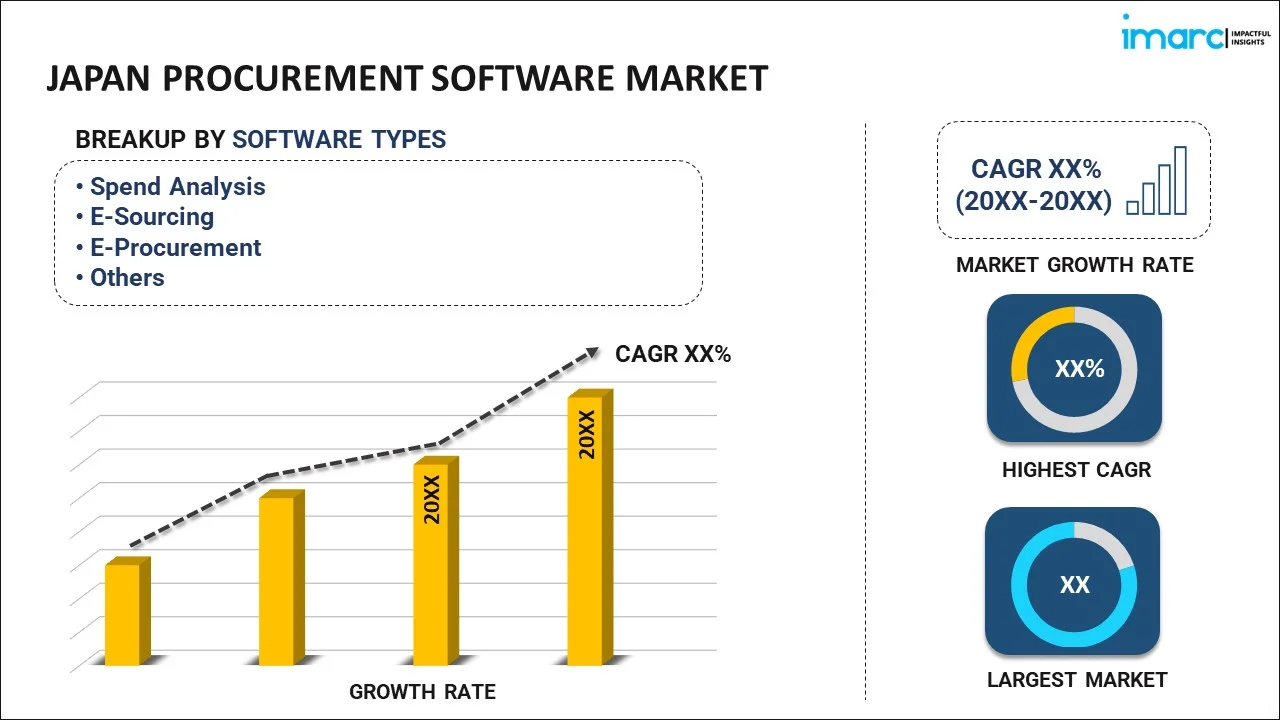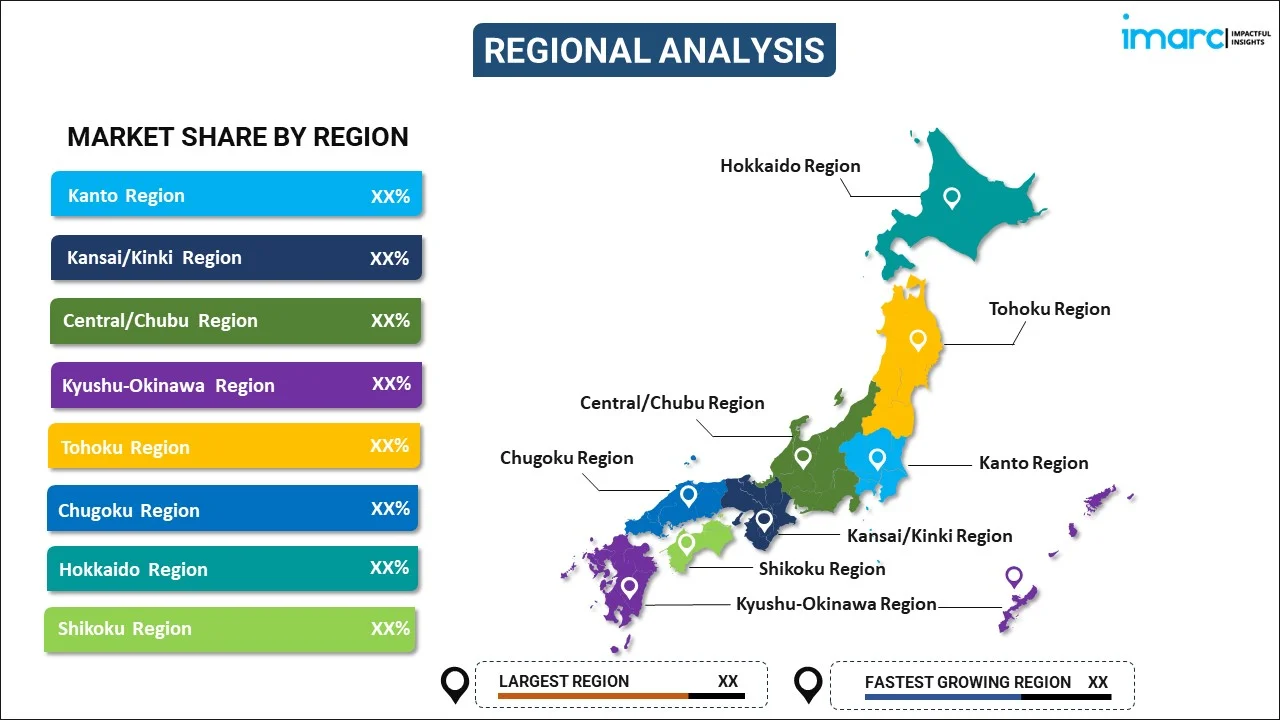
Japan Procurement Software Market Report by Software Type (Spend Analysis, E-Sourcing, E-Procurement, Contract Management, Supplier Management, and Others), Deployment (Cloud-based, On-premises), Organization Size (Small and Medium-sized Enterprises, Large Enterprise), Vertical (Retail, Automotive, Travel and Logistics, Electronics, IT and Telecommunication, and Others), and Region 2025-2033
Market Overview:
Japan procurement software market size reached USD 485.0 Million in 2024. Looking forward, IMARC Group expects the market to reach USD 1,089.3 Million by 2033, exhibiting a growth rate (CAGR) of 9.4% during 2025-2033. The integration of advanced analytics and business intelligence tools within procurement software that allows organizations to make data-driven decisions, is driving the market.
|
Report Attribute
|
Key Statistics
|
|---|---|
|
Base Year
|
2024 |
|
Forecast Years
|
2025-2033
|
|
Historical Years
|
2019-2024
|
| Market Size in 2024 | USD 485.0 Million |
| Market Forecast in 2033 | USD 1,089.3 Million |
| Market Growth Rate (2025-2033) | 9.4% |
Procurement software is a technological solution designed to streamline and automate the procurement process within organizations. It encompasses a range of tools and features that facilitate the sourcing, purchasing, and management of goods and services. Key functionalities include supplier management, e-sourcing, contract management, and purchase order automation. This software enhances efficiency by centralizing procurement activities, ensuring compliance with regulations, and optimizing cost control. It enables real-time collaboration between various stakeholders, improves transparency in procurement workflows, and helps organizations make data-driven decisions. Additionally, procurement software often integrates with other enterprise systems, such as ERP (enterprise resource planning), to provide a seamless end-to-end solution. Overall, procurement software is a crucial component for organizations seeking to enhance procurement processes, reduce manual work, and achieve better control over their supply chain operations.
Japan Procurement Software Market Trends:
The procurement software market in Japan is witnessing robust growth, driven by several key factors. Firstly, the increasing emphasis on cost optimization and operational efficiency propels organizations to adopt advanced procurement solutions. Moreover, the rising complexity of regional supply chains necessitates the implementation of sophisticated software to streamline procurement processes. In addition, the growing awareness of the benefits associated with e-procurement, such as reduced manual errors and enhanced visibility, acts as a catalyst for market expansion. Furthermore, the escalating demand for real-time data analytics and reporting capabilities fuels the adoption of procurement software, enabling organizations to make informed decisions and adapt to dynamic market conditions. Additionally, the integration of artificial intelligence and machine learning in procurement solutions is a major driver, empowering businesses to automate routine tasks, forecast demand more accurately, and identify cost-saving opportunities. The trend towards remote work and the need for collaborative procurement platforms contribute to the market's momentum as businesses seek agile and accessible solutions. Lastly, regulatory compliance requirements in various industries, which propel the adoption of procurement software to ensure adherence to standards and mitigate risks, are expected to drive the procurement software market in Japan in the coming years.
Japan Procurement Software Market Segmentation:
IMARC Group provides an analysis of the key trends in each segment of the market, along with forecasts at the country level for 2025-2033. Our report has categorized the market based on software type, deployment, organization size, and vertical.
Software Type Insights:

- Spend Analysis
- E-Sourcing
- E-Procurement
- Contract Management
- Supplier Management
- Others
The report has provided a detailed breakup and analysis of the market based on the software type. This includes spend analysis, e-sourcing, e-procurement, contract management, supplier management, and others.
Deployment Insights:
- Cloud-based
- On-premises
A detailed breakup and analysis of the market based on the deployment have also been provided in the report. This includes cloud-based and on-premises.
Organization Size Insights:
- Small and Medium-sized Enterprises
- Large Enterprise
The report has provided a detailed breakup and analysis of the market based on the organization size. This includes small and medium-sized enterprises and large enterprise.
Vertical Insights:
- Retail
- Automotive
- Travel and Logistics
- Electronics
- IT and Telecommunication
- Others
A detailed breakup and analysis of the market based on the vertical have also been provided in the report. This includes retail, automotive, travel and logistics, electronics, IT and telecommunication, and others.
Regional Insights:

- Kanto Region
- Kansai/Kinki Region
- Central/ Chubu Region
- Kyushu-Okinawa Region
- Tohoku Region
- Chugoku Region
- Hokkaido Region
- Shikoku Region
The report has also provided a comprehensive analysis of all the major regional markets, which include Kanto Region, Kansai/Kinki Region, Central/ Chubu Region, Kyushu-Okinawa Region, Tohoku Region, Chugoku Region, Hokkaido Region, and Shikoku Region.
Competitive Landscape:
The market research report has also provided a comprehensive analysis of the competitive landscape. Competitive analysis such as market structure, key player positioning, top winning strategies, competitive dashboard, and company evaluation quadrant has been covered in the report. Also, detailed profiles of all major companies have been provided.
Japan Procurement Software Market Report Coverage:
| Report Features | Details |
|---|---|
| Base Year of the Analysis | 2024 |
| Historical Period | 2019-2024 |
| Forecast Period | 2025-2033 |
| Units | Million USD |
| Scope of the Report | Exploration of Historical and Forecast Trends, Industry Catalysts and Challenges, Segment-Wise Historical and Predictive Market Assessment:
|
| Software Types Covered | Spend Analysis, E-Sourcing, E-Procurement, Contract Management, Supplier Management, Others |
| Deployments Covered | Cloud-based, On-premises |
| Organization Sizes Covered | Small and Medium-sized Enterprises, Large Enterprise |
| Verticals Covered | Retail, Automotive, Travel and Logistics, Electronics, IT and Telecommunication, Others |
| Regions Covered | Kanto Region, Kansai/Kinki Region, Central/ Chubu Region, Kyushu-Okinawa Region, Tohoku Region, Chugoku Region, Hokkaido Region, Shikoku Region |
| Customization Scope | 10% Free Customization |
| Post-Sale Analyst Support | 10-12 Weeks |
| Delivery Format | PDF and Excel through Email (We can also provide the editable version of the report in PPT/Word format on special request) |
Key Questions Answered in This Report:
- How has the Japan procurement software market performed so far and how will it perform in the coming years?
- What has been the impact of COVID-19 on the Japan procurement software market?
- What is the breakup of the Japan procurement software market on the basis of software type?
- What is the breakup of the Japan procurement software market on the basis of deployment?
- What is the breakup of the Japan procurement software market on the basis of organization size?
- What is the breakup of the Japan procurement software market on the basis of vertical?
- What are the various stages in the value chain of the Japan procurement software market?
- What are the key driving factors and challenges in the Japan procurement software?
- What is the structure of the Japan procurement software market and who are the key players?
- What is the degree of competition in the Japan procurement software market?
Key Benefits for Stakeholders:
- IMARC’s industry report offers a comprehensive quantitative analysis of various market segments, historical and current market trends, market forecasts, and dynamics of the Japan procurement software market from 2019-2033.
- The research report provides the latest information on the market drivers, challenges, and opportunities in the Japan procurement software market.
- Porter's five forces analysis assist stakeholders in assessing the impact of new entrants, competitive rivalry, supplier power, buyer power, and the threat of substitution. It helps stakeholders to analyze the level of competition within the Japan procurement software industry and its attractiveness.
- Competitive landscape allows stakeholders to understand their competitive environment and provides an insight into the current positions of key players in the market.
Need more help?
- Speak to our experienced analysts for insights on the current market scenarios.
- Include additional segments and countries to customize the report as per your requirement.
- Gain an unparalleled competitive advantage in your domain by understanding how to utilize the report and positively impacting your operations and revenue.
- For further assistance, please connect with our analysts.
 Inquire Before Buying
Inquire Before Buying
 Speak to an Analyst
Speak to an Analyst
 Request Brochure
Request Brochure
 Request Customization
Request Customization




.webp)




.webp)












